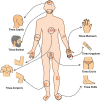Superficial Dermatophytosis across the World's Populations: Potential Benefits from Nanocarrier-Based Therapies and Rising Challenges
- PMID: 37692246
- PMCID: PMC10483660
- DOI: 10.1021/acsomega.3c01988
Superficial Dermatophytosis across the World's Populations: Potential Benefits from Nanocarrier-Based Therapies and Rising Challenges
Abstract
The most prevalent infection in the world is dermatophytosis, which is a major issue with high recurrence and can affect the entire body including the skin, hair, and nails. The major goal of this Review is to acquire knowledge about cutting-edge approaches for treating dermatophytosis efficiently by adding antifungals to formulations based on nanocarriers in order to overcome the shortcomings of standard treatment methods. Updates on nanosystems and research developments on animal and clinical investigations are also presented. Along with the currently licensed formulations, the investigation also emphasizes novel therapies and existing therapeutic alternatives that can be used to control dermatophytosis. The Review also summarizes recent developments on the prevalence, management approaches, and disadvantages of standard dosage types. There are a number of therapeutic strategies for the treatment of dermatophytosis that have good clinical cure rates but also drawbacks such as antifungal drug resistance and unfavorable side effects. To improve therapeutic activity and get around the drawbacks of the traditional therapy approaches for dermatophytosis, efforts have been described in recent years to combine several antifungal drugs into new carriers. These formulations have been successful in providing improved antifungal activity, longer drug retention, improved effectiveness, higher skin penetration, and sustained drug release.
© 2023 The Authors. Published by American Chemical Society.
Conflict of interest statement
The authors declare no competing financial interest.
Figures





Similar articles
-
Nanotechnological interventions in dermatophytosis: from oral to topical, a fresh perspective.Expert Opin Drug Deliv. 2019 Apr;16(4):377-396. doi: 10.1080/17425247.2019.1593962. Epub 2019 Apr 3. Expert Opin Drug Deliv. 2019. PMID: 30871388 Review.
-
Naftifine: A Topical Allylamine for Superficial Dermatophytosis.J Assoc Physicians India. 2023 May;71(5):11-12. doi: 10.5005/japi-11001-0241. J Assoc Physicians India. 2023. PMID: 37355825
-
Indian Association of Dermatologists, Venereologists and Leprologists (IADVL) Task Force against Recalcitrant Tinea (ITART) Consensus on the Management of Glabrous Tinea (INTACT).Indian Dermatol Online J. 2020 Jul 13;11(4):502-519. doi: 10.4103/idoj.IDOJ_233_20. eCollection 2020 Jul-Aug. Indian Dermatol Online J. 2020. PMID: 32832435 Free PMC article.
-
Conventional and natural compounds for the treatment of dermatophytosis.Med Mycol. 2020 Aug 1;58(6):707-720. doi: 10.1093/mmy/myz116. Med Mycol. 2020. PMID: 31773153 Review.
-
Determination of antifungal minimum inhibitory concentration and its clinical correlation among treatment failure cases of dermatophytosis.J Family Med Prim Care. 2019 Aug 28;8(8):2577-2581. doi: 10.4103/jfmpc.jfmpc_483_19. eCollection 2019 Aug. J Family Med Prim Care. 2019. PMID: 31548935 Free PMC article.
Cited by
-
Layer-by-Layer Biopolymer-Coated Deformable Liposomes-In Situ Gel: A Hybrid Strategy for Enhanced Ocular Delivery of Itraconazole: In Vitro and In Vivo Appraisal.Gels. 2024 Dec 31;11(1):19. doi: 10.3390/gels11010019. Gels. 2024. PMID: 39851990 Free PMC article.
-
Humans vs. Fungi: An Overview of Fungal Pathogens against Humans.Pathogens. 2024 May 17;13(5):426. doi: 10.3390/pathogens13050426. Pathogens. 2024. PMID: 38787278 Free PMC article. Review.
-
Host-Pathogen Interaction and Resistance Mechanisms in Dermatophytes.Pathogens. 2024 Aug 4;13(8):657. doi: 10.3390/pathogens13080657. Pathogens. 2024. PMID: 39204257 Free PMC article. Review.
-
Bioinformatics-Driven mRNA-Based Vaccine Design for Controlling Tinea Cruris Induced by Trichophyton rubrum.Pharmaceutics. 2024 Jul 25;16(8):983. doi: 10.3390/pharmaceutics16080983. Pharmaceutics. 2024. PMID: 39204328 Free PMC article.
-
Discovery of semisynthetic derivatives of (R)- and (S)-usnic acids as potential antifungal agents against C. tropicalis and T. rubrum.RSC Med Chem. 2025 Jul 10. doi: 10.1039/d5md00457h. Online ahead of print. RSC Med Chem. 2025. PMID: 40689027 Free PMC article.
References
-
- Kumar Nigam P. Antifungal Drugs and Resistance: Current Concepts. Our Dermatology Online 2015, 6, 212.10.7241/ourd.20152.58. - DOI
Publication types
LinkOut - more resources
Full Text Sources

